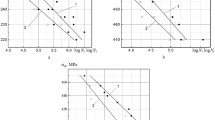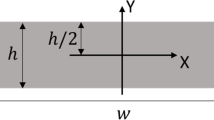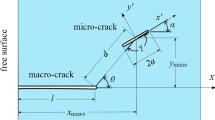Abstract
The crack tip stress intensity factorK 1 for a short crack is determined using the double slip plane (DSP) crack model. It is shown thatK 1 for a stationary crack is larger than the nominal stress intensity factorK. This result differs from the case of the stationary DSP long crack for whichK 1 =K. The physical cause whyK 1 >K is the fall off with distance of the dislocation shielding/antishielding factor I. at a rate faster than an inverse square root dependence when the distance from a dislocation to a crack tip is of the order of or larger than the crack half widtha. The value ofL for a dislocation situated at an arbitrary position about a crack is derived in this paper. (The Rice-Thomson expressions forL are valid only if a dislocation is very close to a crack tip.) The short short-crack is also analysed using the DSP crack model. (A short short-crack crack is defined to be a short crack whose plastic zone behind the crack tip extends to the center of the crack.) The value of K1 for the short short-crack is a constant and is larger than K. Finally, it is shown that if the crack length is smaller than a critical value that is inversely proportional to the yield stress and is proportional to the critical stress intensity factor Kcb of a Griffith crack that K1 must be smaller than K,t, regardless of how closely the applied stress approaches the yield stress. These results imply that fatigue crack growth of short cracks in the DSP crack model occurs at a faster rate than for long cracks when the conventional cyclic stress intensity factor is above the threshold value and that short cracks can grow under cyclic stress intensity factors smaller than the threshold value.
Résumé
On détermine le facteur d'intensité d'entailleK 1, à l'extrémité d'une fissure courte en recourant au modèle de fissure à double plan de glissement DSP). On montre que, pour une fissure stationnaire,K 1 est plus grand que le facteur d'intensité de contrainte nominalK. Ce résultat se distingue du cas où l'on applique le modèle DSP à une fissure longue, qui conduit àK 1 =K. La raison physique pour laquelleK 1 >K réside dans le fait que lorsque la distance qui sépare une dislocation d'une fissure est égale ou supérieure à la demi largeur de la fissure, le facteurL de bloquage/débloquage des dislocations s'estompe rapidement en fonction de la distance.
On établit dans l'étude la valeur deL correspondant à une dislocation sise dans une position arbitraire par rapport à une fissure (à noter que les expressions de Rice-Thompson pour L ne sont applicables que si la dislocation est très proche de l'extrémité de la fissure). On étudie également é l'aide du modèle DSP le cas de la fissure courte-courte, que l'on définit comme celle dont la zone plastique derrière son extrémité s'étend jusqu'à son centré. La valeur deK t pour une fissure courte-courte est une constante et est supérieure à K. Enfin, on montre que si la longueur de la fissure ne dépasse pas une valeur critique, inversement proportionnelle à la contrainte limite d'écoulement et proportionnelle au facteur d'intensité de contraintesK cb d'une fissure de Griffith, la valeur deK t doit être inférieure àK cb, quelque proche de la contrainte limite d'écoulement que soit la contrainte appliquée.
Ces résultats impliquent que la vitesse de propagation d'une fissure courte par fatique suivant le modèle DSP est supérieure à celle relative à une fissure longue, lorsque le facteur conventionnel de concentration de contraintes cycliques dépasse une valeur de seuil, et que des fissures courtes peuvent s'étendre sous un facteur d'intensité de contraintes cycliques plus petit que cette valeur de seuil.
Similar content being viewed by others
References
S. Suresh and R.O. Ritchie, The propagation of short fatigue cracks,International Metals Review (in press).
J. Weertman, I.-H. Lin and R. Thomson, Acta Metallurgica 31 (1983) 473.
J. Weertman,Acta Metallurgica 32 (1984) 575.
T. Mura and J. Weertman, Dislocation models for threshold fatigue crack growth, in Concepts of Fatigue Crack Growth Thresholds, eds. D.L. Davidson and S. Suresh, The Metallurgical Society of AIME, Warrendale, PA (1984) (in press).
J. Weertman,Acta Metallurgica 32 (1984) 563.
J. Weertman,Mechanics of Materials 2 (1983) 331.
R. Thomson,Journal of Materials Science 13 (1978) 128.
J. Weertman,Acta Metallurgica 26 (1978) 1731.
B.A. Bilby, A.H. Cottrell and K.H. Swinden,Proceedings of the Roval Society 272A (1963) 304.
J. Weertman,Philosophical Magazine 43A (1981) 1103.
J.R. Rice and R. Thomson,Philosophical Magazine 29 (1974) 73.
Author information
Authors and Affiliations
Rights and permissions
About this article
Cite this article
Weertman, J. Crack tip stress intensity factor of the double slip plane crack model: Short cracks and short short-cracks. Int J Fract 26, 31–42 (1984). https://doi.org/10.1007/BF01152310
Received:
Issue Date:
DOI: https://doi.org/10.1007/BF01152310




